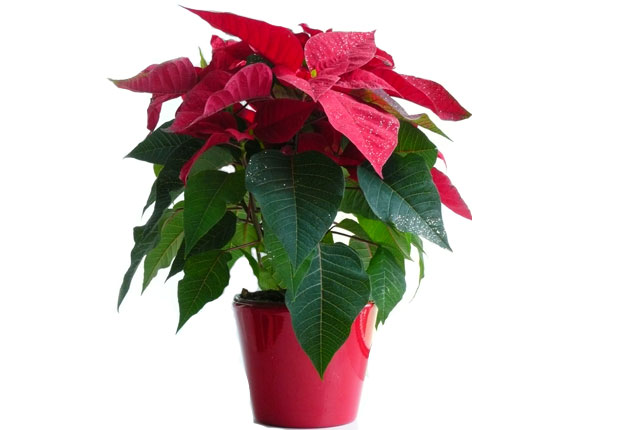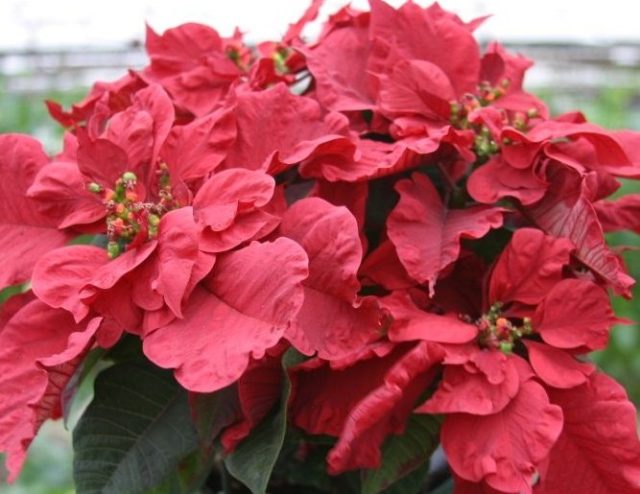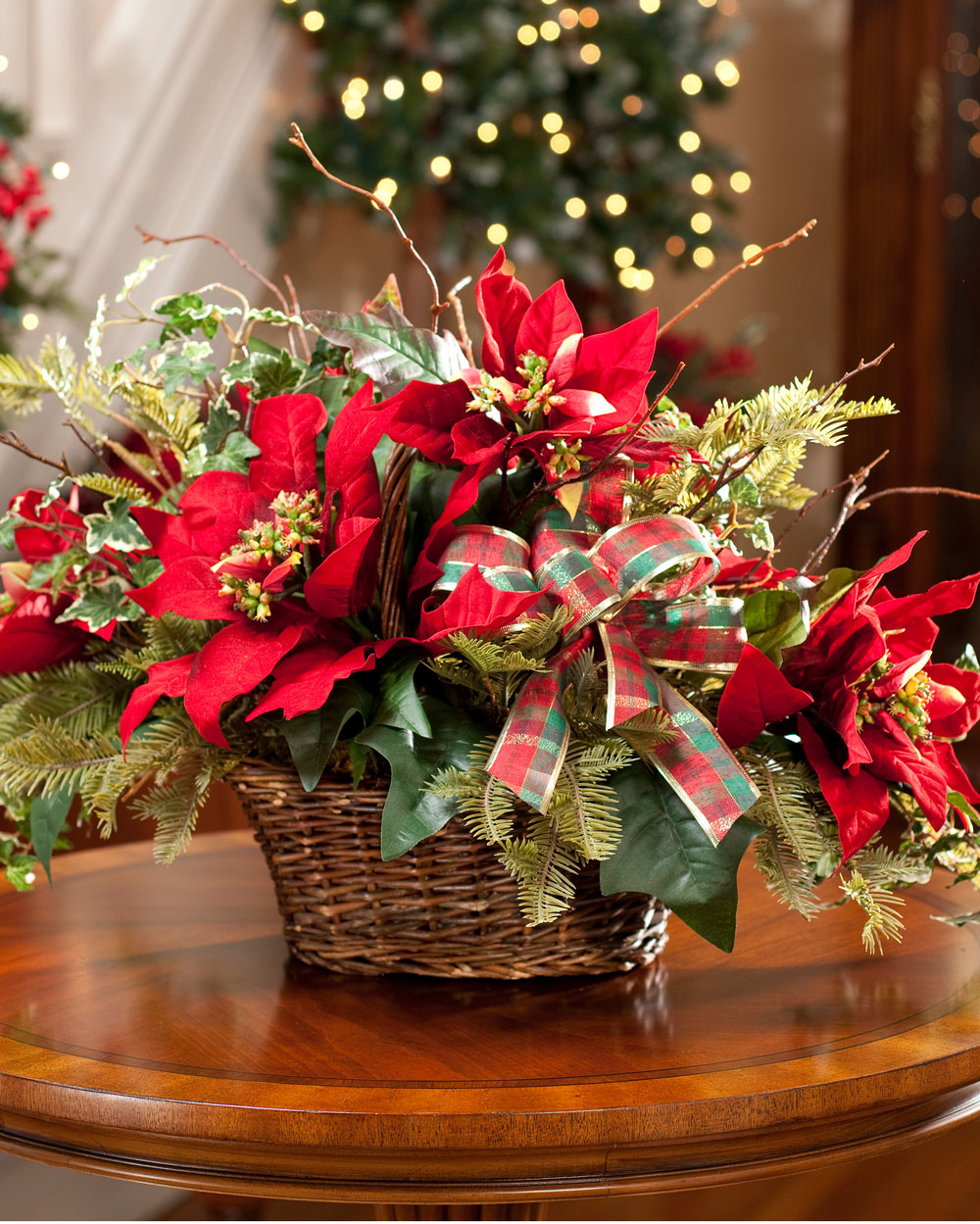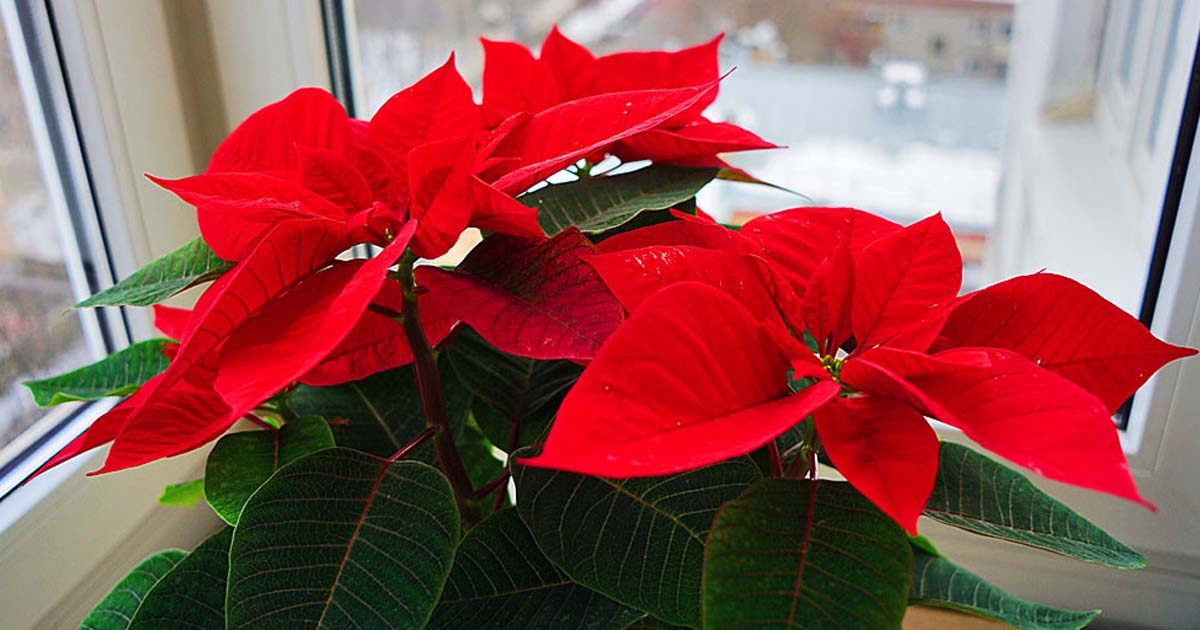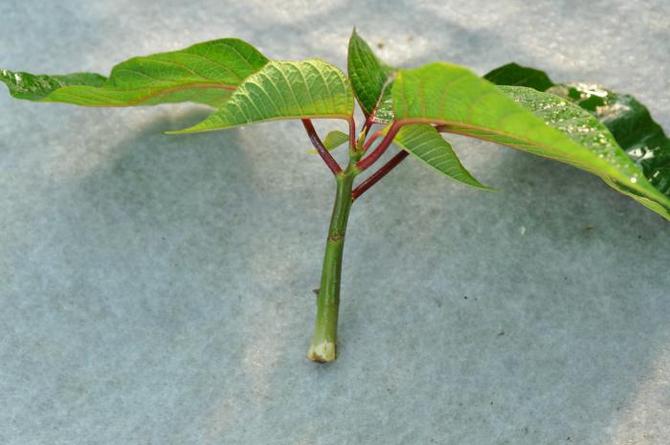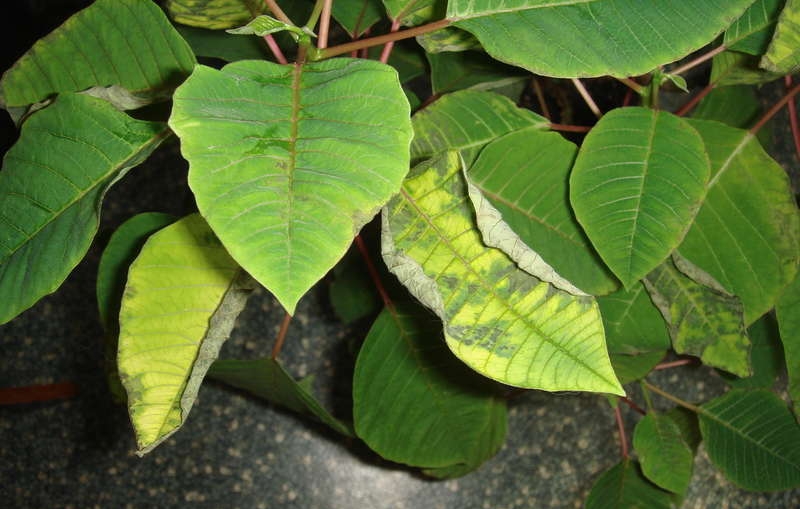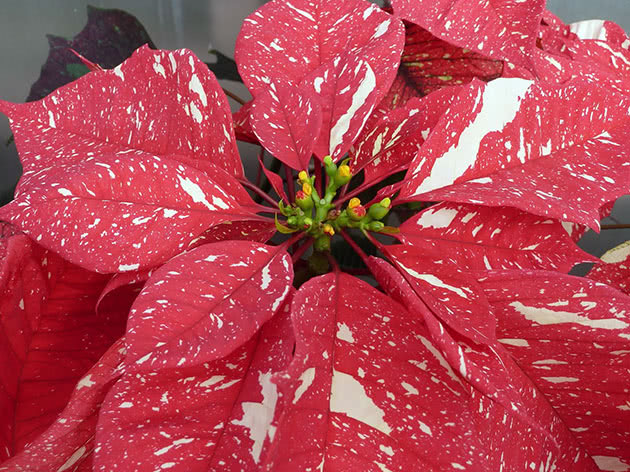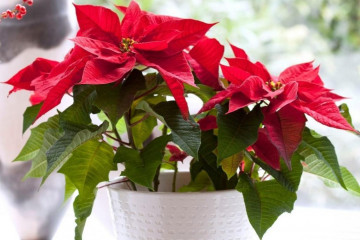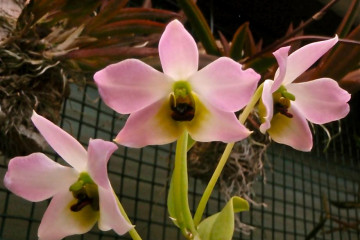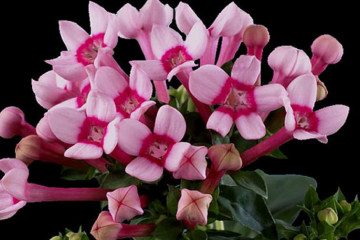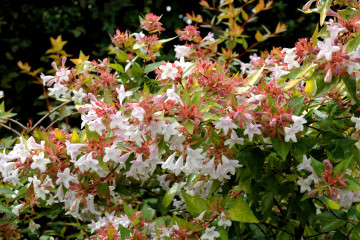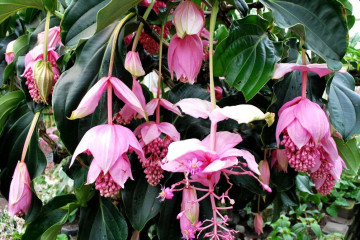Poinsettia: home care and plant propagation options
Content:
Poinsettia, or Euphorbia, is an evergreen plant that originated in the rainforests of America and Mexico. In the natural environment, it reaches 4 meters, at home, the height does not exceed 50 centimeters. An attractive poinsettia is made by leaves located around nondescript flowers.
The main types of poinsettia
The inflorescences of the plant are a small rosette. It is difficult to notice because of the beautiful leaves growing around. They are called bracts. Their color can be different: red, peach, lemon and even spotted. The lower leaves of the poinsettia are dark green, against their background the bracts look more impressive. At first glance, it seems that these flowers have blossomed at the top of the plant.
Poinsettia red
Red poinsettia blooms during the New Year holidays. Therefore, it is often called the Christmas star. Such a flowering period is a rare occurrence among plants, because in winter there is the shortest daylight hours. Dense leaves form a voluminous crown. If the plant refuses to blush, it means that it is not satisfied with the created conditions. Most often this is lack of rest, when a decrease in the temperature in the room is required. Bracts resembling stars create a sense of celebration and lift your spirits.
New Year's or red poinsettia is the most common in the flower world. This is the only plant of this kind that exists in the wild. Further, varieties appeared, created on the basis of a bright red predecessor, found at the beginning of the 19th century.
The leaves of one of the first artificially bred poinsettias were shaped like the crown of an oak and had a red-orange hue. These varieties continue to be popular. For example, the Da Vinci poinsettia, in addition to the cut leaves, is characterized by their pale pink tint and scarlet splashes that set off the delicate color.
Poinsettia Carousel
Plants are distinguished by leaves with curled edges. The inflorescences themselves have a pink tint, the crown around them is dark scarlet or lighter. So far, breeders have developed only two varieties of similar poinsettias.
Other types
There are poinsettias with bulky leaves. The flower resembles a blossoming rose or peony. If the classic red poinsettia leaves are even, straight, pointed at the end, then here they are bent and slightly crumpled. The bracts appear to be made of cloth. The terry ball can have several shades. There are milk poinsettias, scarlet and pink. Some combine several shades in the petals. A plant with pink bract leaves with green stripes along the edges looks unusual.
Plants with variegated leaves deserve special attention. Some of them have a border around the edges of a color that is different from the main shade. Others are distinguished by light splashes chaotically scattered over the foliage. For example, when looking at the Jingle Bells variety, it seems that the red leaves are covered with snowflakes, scattered in disarray on the surface. Bracts of other representatives, on the contrary, are distinguished by light petals covered with small dots of scarlet splashes.
Home care
Poinsettia, the care of which is not too burdensome, requires attention.If you follow simple rules, the flower will grow and delight others with its attractive appearance. It is attention and care that will help the milkweed turn red for the Christmas holidays.
Watering
Abundant watering is required for the plant during the flowering period and in summer. Only the top layer of soil in the pot should dry out.
In winter, the soil is moistened much less frequently. The number of waterings is reduced.
Poinsettia flower in the house how to care for high humidity:
- Spray. You can do this at some distance from the flower in order to prevent the formation of ugly spots on the leaf. If you spray directly the leaves of the flower, then use only warm water, as for watering;
- Use humidifiers;
- Put on the windowsill next to the poinsettia a pot of wet expanded clay or just a container of water.
Top dressing
When poinsettia blooms, home care involves the use of potassium-containing dressings. Fertilize the soil usually from early spring to late autumn. In summer, it is allowed to use mullein diluted in water. A weak solution will replace the mineral fertilizer complex. You need to apply top dressing to the soil twice a month.
Temperature
Poinsettia red how to care at home to make the plant feel comfortable:
- Create an average temperature ranging from 18 to 24 degrees. Being in a too warm or cold room leads to a disease of the flower and its possible death. This temperature regime is required during active growth;
- Provide cooler conditions during flowering. In this case, the temperature is needed about 16 degrees;
- During rest, the thermometer should drop a couple more divisions. It begins after the plant has faded;
- Protect from sudden temperature fluctuations, drafts. It must be remembered that even being near a cold window, if the leaves touch it, can be detrimental to the plant.
Step-by-step care recommendations apply to all plant varieties, but red poinsettia is most common among flower growers.
Illumination
The poinsettia flower loves diffused sunlight. The plant must be protected from direct exposure to bright rays. In winter, during flowering, you need to use additional lighting. This is especially true for the evening.
Transplant and pruning
A transplant is recommended every year. The most suitable time for this is April-May, the period after the dormancy of the plant. When young leaves appear on the poinsettia, you need to start the process.
For planting, use soil with low acidity. To prepare it, you will need:
- turf and clay earth - 3 parts;
- leaf land - 2 parts;
- sand - 2 parts;
- peat - 1 part.
First, the soil is disinfected. To do this, pour over a solution of potassium permanganate and hot water. When transplanting, the pot should be 2-3 centimeters larger than the previous one. To make the plant easy to remove, water it abundantly the day before the procedure. Fill the new pot with drainage by 3 centimeters. Remove the poinsettia, keeping the clod of earth. Remove injured and dead roots. Place the plant in a new pot and cover with prepared soil. It is not necessary to water immediately, as the soil must be moistened.
Prune the plant after flowering, leaving stems about 10 centimeters long. They also carry out the procedure after dormancy, when new shoots appear. In order for the forces to be directed to their growth, the old ones are removed so that about 5-6 stems remain. Cut off shoots are essential for the propagation of the plant.
Reproduction methods
Poinsettia Christmas star and other plant varieties are easy to propagate at home.You need to prepare in advance for the process so as not to harm the flower.
Seeds
Seeds are formed in a plant in its natural environment after flowering. It is almost impossible to get them at home. In addition, in this case, the properties obtained during the work of breeders are lost. Therefore, spurge at home is propagated by cuttings.
Cuttings
Cuttings are carried out at the beginning of summer. The cut on the plant is made under the knot. At the same time, the shoot reaches a length of 8-10 centimeters. The main thing is that there are several kidneys left on it.
Then the shoot should dry at room temperature, after which it is ready for planting in the ground. For its preparation, peat and sand are used, they are taken in equal volumes.
The cuttings are treated with a solution that stimulates root growth, planted in the prepared mixture. Place no more than one centimeter deep. Otherwise, the escape may rot. The container is placed in a bright and warm place, while the temperature should be about 25 degrees. Cuttings need to be sprayed, ventilated. A young plant, like an adult, loves fresh air. The main thing is to exclude drafts. Also, the seedlings are covered with a film, this speeds up rooting. The process usually takes 3-4 weeks. After the formation of the roots, a pinch is done so that the poinsettia branches. It will also help to form a beautifully shaped crown.
Plant diseases
Poinsettia can lose its attractiveness with improper care, lack of comfortable conditions. The plant is attacked by fungi and insects.
Leaves turn yellow
To please the eye with poinsettia, home care should include creating high humidity. Otherwise, the plant will get sick, the leaves will turn yellow, droop and curl up into a tube. Therefore, you need to check the moisture content of the soil and monitor the indoor conditions. The soil should never dry out completely.
Over-watering is also dangerous for poinsettia. The roots can rot with excess moisture, so it is recommended to pour drainage into the pot and remove water from the pan.
Leaves fall
Poinsettia leaves fall off as a result of exposure to cold. The plant is sensitive to low temperatures, so even a few minutes in the cool can harm it. As a result, the leaves curl and fall off. Euphorbia often dies almost immediately after purchase. This is due to improper transportation conditions, when the plant freezes upon delivery home. It is better not to buy poinsettia on frosty and windy days. Even if it is well packed, it can still freeze. Gusts of wind, cold or warm, can also be harmful, causing leaves to fall off. Therefore, it is important to protect euphorbia from drafts and hypothermia.
Lack of light causes leaves to fall off the bottom of the plant. Therefore, in winter, when there is little sun, it is necessary to organize artificial lighting.
Other problems
Sometimes poinsettia is attacked by pests that cause her inconvenience and threaten her health. Most often, the plant is attacked:
- Thrips. They feed on the sap of the plant, laying colonies of larvae on the back of the leaf. You can see black dots on it, later it starts to fade;
- Spider mite. The first sign of the appearance of an insect is a thin web between the leaves of the plant;
- Mealybug. They find themselves in lumps of cotton wool covering the leaves and stems of the plant.
Dealing with them is easy. Usually, a soap solution is used to wipe the leaves.After that, the plant must be rinsed under a warm shower. In this case, it is important not to wet the soil and roots. To do this, cover the pot with a film that does not allow water to pass through.
If the leaves turn black and begin to fall off, most likely, gray rot is to blame. In addition, the flower can infect white bloom, another fungal disease. Special drugs help to fight them. It is recommended to transplant the plant in case of illness.
Resuscitation methods
Growing poinsettia is easy. Creating comfortable conditions will help avoid problems, and the plant will delight the eye with unusual leaves.
Watering should be closely monitored. If the leaves are curled up and the soil is too dry, water the flower abundantly. Then he will return to a healthy look. The lower leaves may still fall off. Spraying will moisturize the plant and get rid of the appearance of spider mites.
All affected leaves must be removed so that the flower does not waste energy on them, but gives them to new shoots. Timely transplanting and pruning will help maintain a blooming appearance.
The poinsettia Christmas flower is popular with flower growers. This is the perfect Christmas present to fill your home with vibrant colors. Unusual leaves will delight all winter when other plants are dormant.
Video
